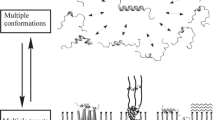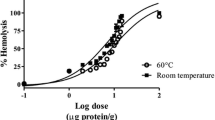Abstract
Cupiennin 1a, a cytolytic peptide isolated from the venom of the spider Cupiennius salei, exhibits broad membranolytic activity towards bacteria, trypanosomes, and plasmodia, as well as human blood and cancer cells. In analysing the cytolytic activity of synthesised all-d- and all-l-cupiennin 1a towards pro- and eukaryotic cells, a stereospecific mode of membrane destruction could be excluded. The importance of negatively charged sialic acids on the outer leaflet of erythrocytes for the binding and haemolytic activity of l-cupiennin 1a was demonstrated. Reducing the overall negative charges of erythrocytes by partially removing their sialic acids or by protecting them with tri- or pentalysine results in reduced haemolytic activity of the peptide.



Similar content being viewed by others
References
Alvarez-Bravo J, Kurata S, Natori S (1994) Novel synthetic antimicrobial peptides effective against methicillin-resistant Staphylococcus aureus. Biochem J 302:535–538
Bergmeyer H, Bernt E (1974) Lactate dehydrogenase: UV assay with pyruvate and NADH. In: Bergmeyer H (ed) Methods of enzymatic analysis. Verlag Chemie, Weinheim, pp 574–579
Bessalle R, Kapitkovsky A, Gorea A, Shalit I, Fridkin M (1990) All-d-magainin: chirality, antimicrobial activity and proteolytic resistance. FEBS Lett 274:151–155
Boulanger N, Brun R, Ehret-Sabatier L, Kunz C, Bulet P (2002) Immunopeptides in the defense reactions of Glossina morsitans to bacterial and Trypanosoma brucei brucei infections. Insect Biochem Mol Biol 32:369–375
Carroll M, McCrorie P (1986) Lipid composition of bloodstream forms of Trypanosoma brucei brucei. Comp Biochem Physiol B 83:647–651
De Bank PA, Kellam B, Kendall DA, Shakesheff KM (2003) Surface engineering of living myoblasts via selective periodate oxidation. Biotechnol Bioeng 81:800–808
Dennison SR, Whittaker M, Harris F, Phoenix DA (2006) Anticancer alpha-helical peptides and structure/function relationships underpinning their interactions with tumour cell membranes. Curr Protein Pept Sci 7:487–499
Ganapaty S, Steve Thomas P, Karagianis G, Waterman PG, Brun R (2006) Antiprotozoal and cytotoxic naphthalene derivatives from Diospyros assimilis. Phytochemistry 67:1950–1956
Henning R, Lange-Mutschler J (1983) Tightly associated lipids may anchor SV40 large T antigen in plasma membrane. Nature 305:736–738
Hesse F, Selzer P, Mühlstadt K, Duszenko M (1995) A novel cultivation technique for long-term maintenance of bloodstream form trypanosomes in vitro. Mol Biochem Parasitol 70:157–166
Hoskin DW, Ramamoorthy A (2008) Studies on anticancer activities of antimicrobial peptides. Biochim Biophys Acta 1778:357–375
Jung HJ, Park Y, Sung WS, Suh BK, Lee J, Hahm KS, Lee DG (2007) Fungicidal effect of pleurocidin by membrane-active mechanism and design of enantiomeric analogue for proteolytic resistance. Biochim Biophys Acta 1768:1400–1405
Kitani H, Naessens J, Kubo M, Nakamura Y, Iraqi F, Gibson J, Yamakawa M (2009) Synthetic nonamer peptides derived from insect defensin mediate the killing of African trypanosomes in axenic culture. Parasitol Res 105:217–225
Kozlov SA, Vassilevski AA, Feofanov AV, Surovoy AY, Karpunin DV, Grishin EV (2006) Latarcins, antimicrobial and cytolytic peptides from the venom of the spider Lachesana tarabaevi (Zodariidae) that exemplify biomolecular diversity. J Biol Chem 281:20983–20992
Kramerova IA, Kawaguchi N, Fessler LI, Nelson RE, Chen YL, Kramerov AA, Kusche-Gullberg M, Kramer JM, Ackley BD, Sieron AL, Prockop DJ, Fessler JH (2000) Papilin in development; a pericellular protein with a homology to the Adamts metalloproteinases. Development 127:5475–5485
Kuhn-Nentwig L (2003) Antimicrobial and cytolytic peptides of venomous arthropods. Cell Mol Life Sci 60:2651–2668
Kuhn-Nentwig L, Schaller J, Kämpfer U, Imboden H, Malli H, Nentwig W (2000) A lysine rich C-terminal tail is directly involved in the toxicity of CSTX-1, a neurotoxic peptide from the venom of the spider Cupiennius salei. Arch Insect Biochem Physiol 44:101–111
Kuhn-Nentwig L, Dathe M, Walz A, Schaller J, Nentwig W (2002a) Cupiennin 1d*: the cytolytic activity depends on the hydrophobic N-terminus and is modulated by the polar C-terminus. FEBS Lett 527:193–198
Kuhn-Nentwig L, Müller J, Schaller J, Walz A, Dathe M, Nentwig W (2002b) Cupiennin 1, a new family of highly basic antimicrobial peptides in the venom of the spider Cupiennius salei (Ctenidae). J Biol Chem 277:11208–11216
Kuhn-Nentwig L, Schaller J, Nentwig W (2004) Biochemistry, toxicology and ecology of the venom of the spider Cupiennius salei (Ctenidae). Toxicon 43:543–553
Li ML, Liao RW, Qiu JW, Wang ZJ, Wu TM (2000) Antimicrobial activity of synthetic all-d mastoparan M. Int J Antimicrob Agents 13:203–208
Löfgren SE, Miletti LC, Steindel M, Bachère E, Barracco MA (2008) Trypanocidal and leishmanicidal activities of different antimicrobial peptides (AMPs) isolated from aquatic animals. Exp Parasitol 118:197–202
Lohner K (2001) The role of membrane lipid composition in cell targeting of antimicrobial peptides. In: Lohner K (ed) Development of novel antimicrobial agents: emerging strategies. Horizon Scientific Press, Wymondham, pp 149–165
Mäntylä T, Sirola H, Kansanen E, Korjamo T, Lankinen H, Lappalainen K, Valimaa AL, Harvima I, Narvanen A (2005) Effect of temporin A modifications on its cytotoxicity and antimicrobial activity. APMIS 113:497–505
Márquez M, Nilsson S, Lennartsson L, Liu Z, Tammela T, Raitanen M, Holmberg AR (2004) Charge-dependent targeting: results in six tumor cell lines. Anticancer Res 24:1347–1351
McGwire BS, Olson CL, Tack BF, Engman DM (2003) Killing of African trypanosomes by antimicrobial peptides. J Infect Dis 188:146–152
Mehlert A, Richardson JM, Ferguson MA (1998) Structure of the glycosylphosphatidylinositol membrane anchor glycan of a class-2 variant surface glycoprotein from Trypanosoma brucei. J Mol Biol 277:379–392
Mehlert A, Bond CS, Ferguson MA (2002) The glycoforms of a Trypanosoma brucei variant surface glycoprotein and molecular modeling of a glycosylated surface coat. Glycobiology 12:607–612
Olson PF, Fessler LI, Nelson RE, Sterne RE, Campbell AG, Fessler JH (1990) Glutactin, a novel Drosophila basement membrane-related glycoprotein with sequence similarity to serine esterases. EMBO J 9:1219–1227
Patnaik PK, Field MC, Menon AK, Cross GA, Yee MC, Bütikofer P (1993) Molecular species analysis of phospholipids from Trypanosoma brucei bloodstream and procyclic forms. Mol Biochem Parasitol 58:97–105
Podda E, Benincasa M, Pacor S, Micali F, Mattiuzzo M, Gennaro R, Scocchi M (2006) Dual mode of action of Bac7, a proline-rich antibacterial peptide. Biochim Biophys Acta 1760:1732–1740
Pukala TL, Boland MP, Gehman JD, Kuhn-Nentwig L, Separovic F, Bowie JH (2007a) Solution structure and interaction of cupiennin 1a, a spider venom peptide, with phospholipid bilayers. Biochemistry 46:3576–3585
Pukala TL, Doyle JR, Llewellyn LE, Kuhn-Nentwig L, Apponyi MA, Separovic F, Bowie JH (2007b) Cupiennin1a, an antimicrobial peptide from the venom of the neotropical wandering spider Cupiennius salei, also inhibits the formation of nitric oxide by neuronal nitric oxide synthase. FEBS J 274:1778–1784
Räz B, Iten M, Grether-Buhler Y, Kaminsky R, Brun R (1997) The Alamar Blue(R) assay to determine drug sensitivity of African trypanosomes (T. b. rhodesiense and T. b. gambiense) in vitro. Acta Trop 68:139–147
Reuter G, Schauer R (1994) Determination of sialic acids. In: Lennarz J, Hart G (eds) Methods in enzymology. Guide to techniques in glycobiology. Academic Press, London New York, pp 168–199
Ruben L, Akins CD, Haghighat NG, Xue L (1996) Calcium influx in Trypanosoma brucei can be induced by amphiphilic peptides and amines. Mol Biochem Parasitol 81:191–200
Sickmann T, Weske B, Dennis RD, Mohr C, Wiegandt H (1992) Chemical distribution of glycosphingolipids in third-instar larval organs of the blowfly, Calliphora vicina (Insecta: Diptera). J Biochem 111:662–669
Thevissen K, Francois IE, Sijtsma L, van Amerongen A, Schaaper WM, Meloen R, Posthuma-Trumpie T, Broekaert WF, Cammue BP (2005) Antifungal activity of synthetic peptides derived from Impatiens balsamina antimicrobial peptides Ib-AMP1 and Ib-AMP4. Peptides 26:1113–1119
Verkleij AJ, Zwaal RF, Roelofsen B, Comfurius P, Kastelijn D, van Deenen LL (1973) The asymmetric distribution of phospholipids in the human red cell membrane. A combined study using phospholipases and freeze-etch electron microscopy. Biochim Biophys Acta 323:178–193
Viitala J, Järnefelt J (1985) The red cell surface revisited. TIBS 10:392–395
Voorheis HP, Gale JS, Owen MJ, Edwards W (1979) The isolation and partial characterization of the plasma membrane from Trypanosoma brucei. Biochem J 180:11–24
Vunnam S, Juvvadi P, Rotondi KS, Merrifield RB (1998) Synthesis and study of normal, enantio, retro, and retroenantio isomers of cecropin A–melittin hybrids, their end group effects and selective enzyme inactivation. J Pept Res 51:38–44
Wade D, Boman A, Wahlin B, Drain CM, Andreu D, Boman HG, Merrifield RB (1990) All-d amino acid-containing channel-forming antibiotic peptides. Proc Natl Acad Sci USA 87:4761–4765
Wade D, Silberring J, Soliymani R, Heikkinen S, Kilpelainen I, Lankinen H, Kuusela P (2000) Antibacterial activities of temporin A analogs. FEBS Lett 479:6–9
Walser A, Rinke Y, Deppert W (1989) Only a minor fraction of plasma membrane-associated large T antigen in simian virus 40-transformed mouse tumor cells (mKSA) is exposed on the cell surface. J Virol 63:3926–3933
Willems J, Noppe W, Moerman L, van der Walt J, Verdonck F (2002) Cationic peptides from scorpion venom can stimulate and inhibit polymorphonuclear granulocytes. Toxicon 40:1679–1683
Willems J, Moerman L, Bosteels S, Bruyneel E, Ryniers F, Verdonck F (2004) Parabutoporin—an antibiotic peptide from scorpion venom—can both induce activation and inhibition of granulocyte cell functions. Peptides 25:1079–1084
Wu MH, Hancock REW (1999) Interaction of the cyclic antimicrobial cationic peptide bactenecin with the outer and cytoplasmic membrane. J Biol Chem 274:29–35
Wullschleger B, Kuhn-Nentwig L, Tromp J, Kämpfer U, Schaller J, Schürch S, Nentwig W (2004) CSTX-13, a highly synergistically acting two-chain neurotoxic enhancer in the venom of the spider Cupiennius salei (Ctenidae). Proc Natl Acad Sci USA 101:11251–11256
Wullschleger B, Nentwig W, Kuhn-Nentwig L (2005) Spider venom: enhancement of venom efficacy mediated by different synergistic strategies in Cupiennius salei. J Exp Biol 208:2115–2121
Yamage M, Yoshiyama M, Grab DJ, Kubo M, Iwasaki T, Kitani H, Ishibashi J, Yamakawa M (2009) Characteristics of novel insect defensin-based membrane-disrupting trypanocidal peptides. Biosci Biotechnol Biochem 73:1520–1526
Acknowledgments
We thank Dr. Heather Murray for critical comments on the manuscript, and the Swiss National Science Foundation for funding.
Author information
Authors and Affiliations
Corresponding author
Rights and permissions
About this article
Cite this article
Kuhn-Nentwig, L., Willems, J., Seebeck, T. et al. Cupiennin 1a exhibits a remarkably broad, non-stereospecific cytolytic activity on bacteria, protozoan parasites, insects, and human cancer cells. Amino Acids 40, 69–76 (2011). https://doi.org/10.1007/s00726-009-0471-0
Received:
Accepted:
Published:
Issue Date:
DOI: https://doi.org/10.1007/s00726-009-0471-0




